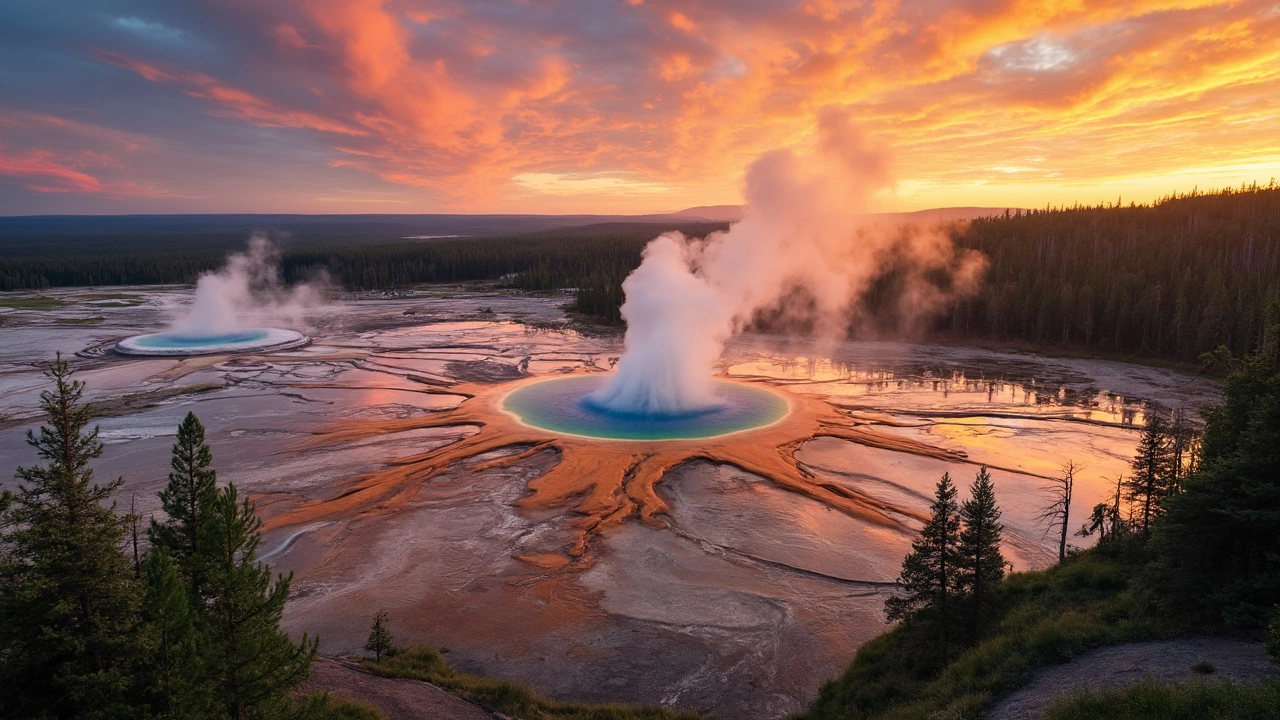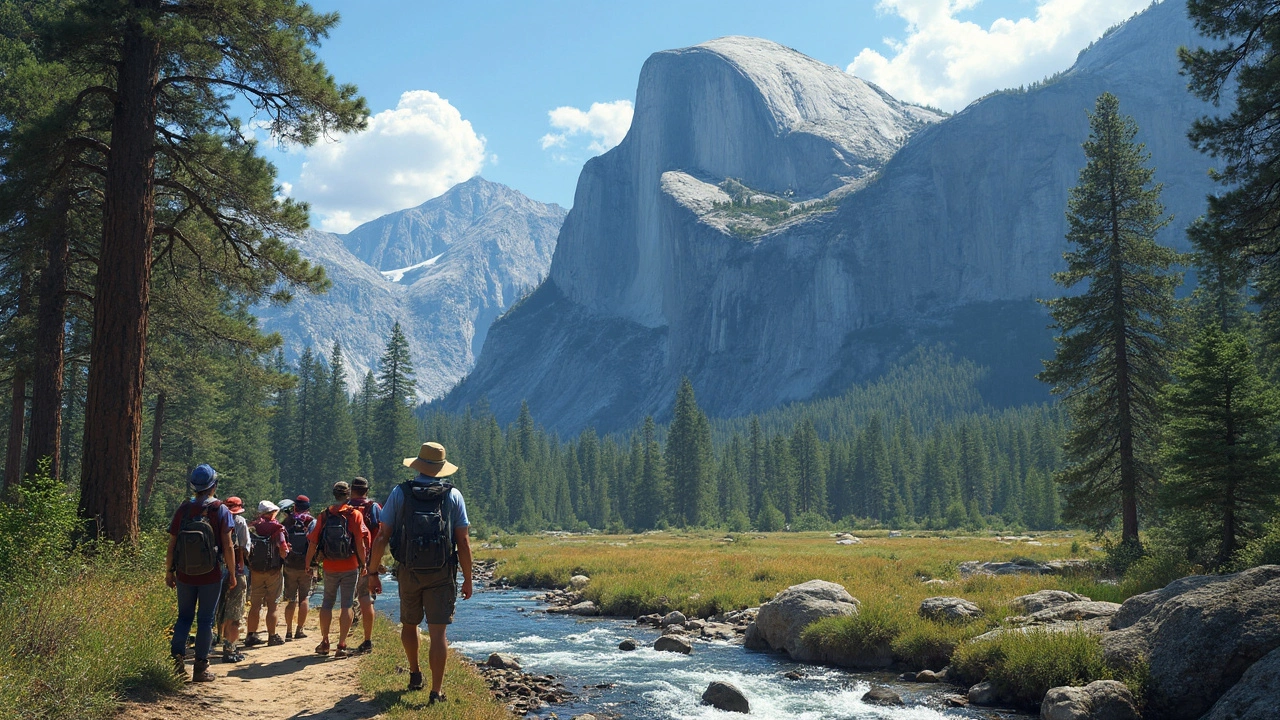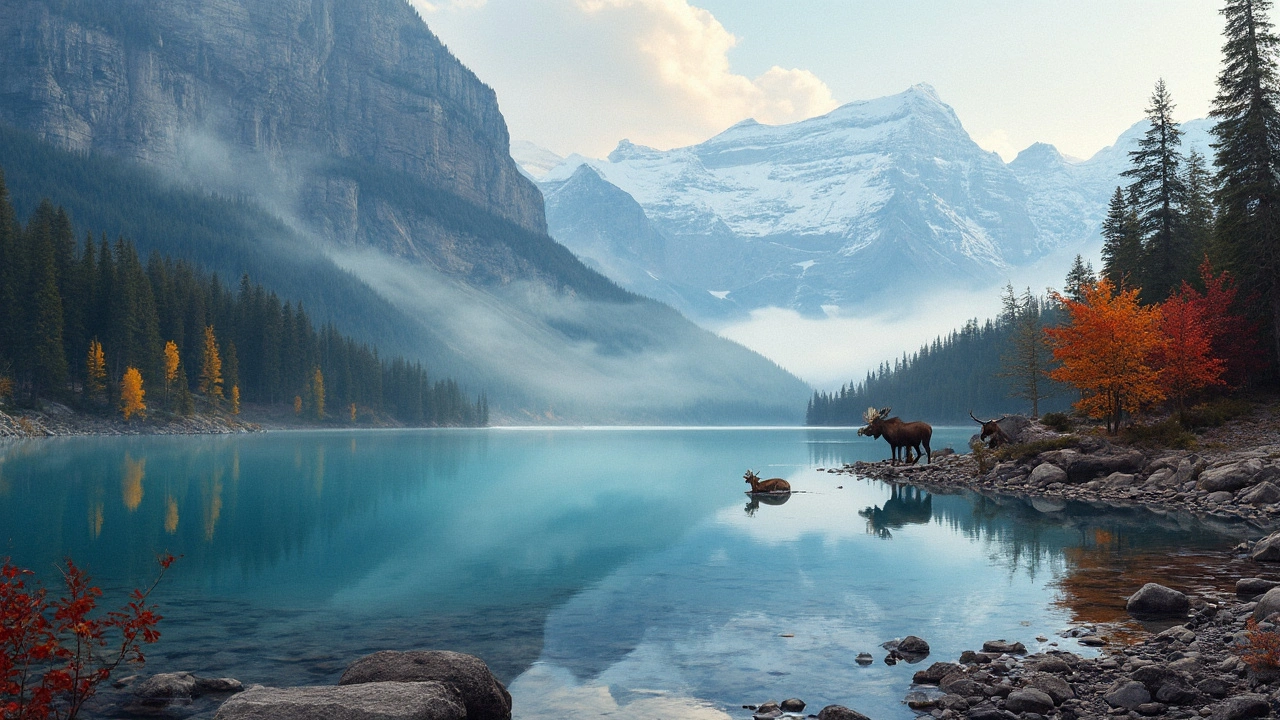Discovering the Most Beautiful National Park: A Guide

Trying to crown the most beautiful national park can be a bit like debating the best pizza topping—everyone has their own favorite, and things can get heated fast! But if you're itching to visit a place where you can feast your eyes on jaw-dropping scenery, there are a few parks that people can't stop talking about.
Let's start with the big names. Yellowstone, with its geysers and hot springs, is basically the superstar of national parks. Then there's Yosemite, where giant sequoias and cliffs create a kind of natural cathedral. We can't forget about Banff in Canada, known for its turquoise lakes that look like they were photoshopped. Intrigued? You're not alone.
If you're thinking about visiting, a little planning goes a long way. These parks can get crowded, so it helps to go during shoulder seasons—like right before summer or just after. And don't forget your camera; you won't want to miss capturing these landscapes. Basically, figuring out what park to visit next really depends on what you're into. Fancy a wild hot spring soak or a serene mountain lake?
- Defining Beauty in a National Park
- Top Contenders for Most Beautiful Park
- Interesting Facts About These Parks
- Tips for Visiting National Parks
- Planning Your Dream Park Tour
Defining Beauty in a National Park
So, what makes a national park beautiful anyway? It's an age-old question, and the answer is often wrapped up in personal taste. However, there are some common features that many folks agree make a park stand out.
The Wow Factor
The most stunning parks often have landscapes that make you stop in your tracks. Think the towering granite walls of Yosemite or the awe-inspiring geysers of Yellowstone. These jaw-dropping views aren't just easy on the eyes; they evoke a sense of wonder that can only be found in nature.
Diversity in Nature
A variety of terrains can really amp up a park's beauty status. For instance, Banff is famous for its mix of forests, rivers, and snow-capped mountains, providing visual treats at every turn. Parks that offer a blend of ecosystems tend to snag that 'most beautiful' title more often because there's something for everyone.
Wildlife Welcome
You know those photos of bears fishing in Alaska? Or elk wandering through open meadows in the Rockies? Wildlife can add a magical touch to any park experience. Yellowstone alone is home to bison, wolves, and grizzlies, showcasing a blend of beauty and wildness that few other places can offer.
Accessibility of Beauty
While remote places can indeed be beautiful, part of what defines a park's splendor is how easy it is for people to experience that beauty. Well-marked trails, scenic drives, and accessible viewpoints play a huge role. More visitors get to share in the beauty, making it a more cherished destination.
Curious about how these parks stack up against each other? Check out our quick comparison:
| Park | Main Feature | Accessibility |
|---|---|---|
| Yosemite | Granite Cliffs | High |
| Yellowstone | Geysers | Medium |
| Banff | Turquoise Lakes | Medium |
Top Contenders for Most Beautiful Park
When it comes to jaw-dropping beauty in national parks, some names pop up often in conversations. Let's talk about why these parks hold a special place in the hearts of travelers.
Yellowstone National Park
Arguably the oldest and perhaps the most famous, Yellowstone is a stunning mix of geothermal wonders and wildlife. Did you know it's home to over half of the world's geysers? The Old Faithful geyser is a must-see, erupting with predictable regularity.
Yosemite National Park
Yosemite is like nature's cathedral with its stunning granite cliffs and giant sequoias. The iconic Half Dome and El Capitan are favorites among climbers and photographers. Even a beginner can have an awe-inspiring experience by just walking to the base of these giants.
Banff National Park
Jumping over to Canada, Banff takes the crown for turquoise lakes and the majestic Rockies. Lake Louise needs no introduction when it comes to Instagram. Hike along its shoreline or canoe in its icy-blue water. It's no wonder Banff consistently makes it to lists of the most beautiful parks.
Grand Canyon National Park
No list would be complete without the Grand Canyon. This park offers dramatic views and spectacular sunsets. There’s a reason millions flock here every year. The South Rim is the most accessible, but those seeking solitude might try the North Rim.
Great Barrier Reef Marine Park
Okay, it’s a bit of a cheat since it’s more ocean than land, but the reef is a work of art. Snorkeling through its vibrant underwater world can feel like stepping into a living painting. Protecting these stunning coral landscapes is crucial.
There you have it, some real contenders for the title of the most beautiful national park. Each offers something unique, and the best part? There's no wrong choice here!

Interesting Facts About These Parks
Diving into the unique aspects of these beautiful national parks, you'll find that each has its fair share of fascinating quirks and stories.
Yellowstone National Park
Yellowstone is not just America's first national park but also the first in the world! Known for its geothermal features, it houses over 500 active geysers—more than anywhere else on the planet. Among them is Old Faithful, a geyser so-named because it erupts at regular intervals, entertaining onlookers multiple times a day.
But wait, there's more than just geysers. Yellowstone is a supervolcano. Yes, you read that right. Below the park is one of the largest active volcanic systems on earth. Kind of wild, right?
Yosemite National Park
Yosemite is like the ultimate playground for rock climbers. Known for its colossal El Capitan granite cliff, this park sees adventurers from all over the globe attempting to scale its heights. Fun fact: Alex Honnold's free solo climb up El Capitan was so impressive, it was even made into a movie.
And those friendly giant sequoias? They’re among the oldest living trees, some standing for more than 3,000 years. These behemoths are awe-inspiring for sure.
Banff National Park
Heading up north to Canada, Banff holds the title of Canada's oldest national park and is part of a UNESCO World Heritage Site. The park is a haven for wildlife, including grizzly bears and moose, which roam freely.
The park's lakes, like Lake Louise, are famous for their stunning turquoise waters—a result of rock flour from glaciers reflecting sunlight. If you've ever wanted to see water this color without a filter, Banff's the place.
There's actually a bonus: if you visit Banff in winter, you're in for a treat. The snowy peaks make for some prime skiing and snowboarding.
Quick Facts Table
| Park Name | Country | Established |
|---|---|---|
| Yellowstone | USA | 1872 |
| Yosemite | USA | 1890 |
| Banff | Canada | 1885 |
This combination of history and natural beauty makes these national parks not just pretty but also layered with stories and secrets waiting to be uncovered.
Tips for Visiting National Parks
Heading out to visit a national park is like gearing up for an adventure of a lifetime. But if you've never been, you might wonder, where do I start? Lucky for you, I've got some solid tips to help you make the most of your trip.
Plan Ahead
You'd be surprised how much smoother things go when you do a bit of planning. Check out peak seasons for your chosen park—trust me, visiting Yellowstone in July means dealing with lots of tourists, while Spring or Fall might give you that peaceful experience you're dreaming of.
Pack Smart
Remember, the weather in national parks can be as unpredictable as they come. Layer up with some durable clothes. A good daypack with essentials like water, snacks, and sunscreen can be a lifesaver when you're surrounded by miles of wilderness.
- Water Bottle: Keep hydrated, especially during those long hikes.
- Snacks: Trail mix, anyone? It's a simple way to keep your energy up.
- Map or GPS: While tech is amazing, a backup never hurts.
Know the Rules
Every park has its own set of guidelines—some are about preserving nature, while others ensure safety. Make sure you understand the 'leave no trace' principle—because no one wants to walk where you've, well, left traces.
Wildlife Etiquette
Spotting wildlife can be the highlight of any national park adventure. But always maintain a safe distance. Use binoculars for a closer look, but do not approach or feed the animals. We’re guests in their home, after all!
Safety First
If you've got your heart set on hiking, let someone know your plans, even if you're going for a short stroll. Parks are vast, and while getting lost in your thoughts is great, getting lost physically is less than ideal!
So, whether it's your first visit or you're a seasoned park explorer, these tips can help you enjoy the beauty and majesty of these incredible places. Happy exploring!

Planning Your Dream Park Tour
Embarking on a tour of the world's most beautiful national park is a dream for many. Whether you’re an experienced adventurer or just looking to soak in nature’s grandeur, a bit of planning goes a long way.
Timing Your Visit
Timing is everything. To avoid the crowds, consider visiting during the shoulder seasons—spring or fall. Not only will you enjoy milder weather, but you'll also have a better shot at snagging the perfect picnic spot without competing with hordes of other travelers.
Booking Essentials
Some parks, like Yellowstone and Yosemite, require you to book campsites or lodges well in advance. Trust us; you don’t want to leave this to chance, especially if you're traveling during peak season. Also, check if you need permits for certain activities like backcountry hiking or rafting.
Packing Smart
There’s no one-size-fits-all list, but a few staples will make your trip a lot smoother. Think layers, sturdy hiking boots, and don’t forget your camera to capture those incredible views. Packing light but smart can make all the difference when you're on the move.
Getting Around
Decide in advance if you're renting a car or relying on park shuttles. Both have pros and cons, but having your vehicle offers flexibility. However, with a shuttle, you don’t have to worry about parking, which can be scarce in popular areas like Banff's Lake Louise.
| Park | Peak Season Visitors |
|---|---|
| Yellowstone | Over 4 million |
| Yosemite | About 3.5 million |
| Banff | Approximately 4 million |
Have a Backup Plan
Even the best-laid plans can go awry. Weather can turn, trails may close, or you might just find a hidden gem worth detouring for. Flexibility is key, and who knows? You might stumble upon your own little slice of paradise.
A successful trip is more about soaking in the experience than chalking off a checklist. Soak in the scenery and take it easy; your soul (and Instagram followers) will thank you.
Look, I get it. National parks are great and all, but let’s be real — none of them come close to representing the sheer majesty of American landscapes like Yellowstone. Sure, Yosemite and Banff are nice, but have you ever seen Old Faithful erupt? It’s a symbol of the raw power and beauty that only America can offer.
People always talk about beauty being subjective, but come on, some things are objectively breathtaking. The ruggedness of the Rockies, the iconic geysers, the vastness of the wilderness — you can’t find that kinda unspoiled nature anywhere else in the world quite like here.
Not to mention, these parks preserve our heritage and remind us why America’s natural land is worth protecting fiercely. Yellowstone alone is a testament to the vision and grit it takes to conserve such treasures. Visiting these parks isn’t just sightseeing; it’s a patriotic act.
So if you want a real taste of the wild and free, skip the tourist traps overseas and hit up the good old USA national parks. There’s nothing like it.
Oh, I love the passion here, but let's widen our lens a bit! 😊 America’s parks are majestic, no doubt, but Banff in Canada is an absolute jewel with those turquoise lakes and mountain peaks that look like they jumped out of a dream.
Every park has its own unique vibe and cultural significance, which makes traveling so much richer. Like, Yosemite with its towering granite cliffs definitely gives you that feeling of insignificance in the grand scheme of nature — kinda poetic, right? 🌲✨
And honestly, it’s not just about science or patriotism (though that’s cool too) but about soaking in the moment, whether that’s spotting wildlife or savoring a sunset. So explore widely and keep your heart and mind open! That's where the magic happens.
Ah, the eternal debate over what constitutes “beauty” in nature. But isn’t the desire to label and rank these experiences kind of missing the point? 🤔
Perhaps it’s not about which park is the most aesthetically pleasing, but about how the experience makes us confront our own existence — the fleeting nature of beauty and time itself. Yellowstone, Yosemite, Banff — they’re just canvases on which we paint our internal narratives.
So the guide is helpful, sure, but I wonder if “discovering” is the right word when everything is constantly evolving and subjective. Just food for thought. 🌿
Basically, all three of those parks are mind-blowing, and anyone who loves the outdoors should just hit ‘em all if they can. Can’t pick favorites when every trail, peak, and river has its own story and vibe.
That said, I’ve done some serious hiking in Yosemite, and the views from Half Dome literally took my breath away. Yet, Yellowstone’s geysers and wildlife feels like stepping into a live nature documentary.
Also, not to forget Banff’s crystal-clear waters and chill mountain towns — perfect mix of adventure and relaxation. 10/10 do recommend.
What’s everyone’s must-see or must-do when visiting these parks? I’m always down to compare notes and swap stories.
Ah, these national parks...yet, one must wonder if the actual environmental dynamics and hidden realities are fully disclosed. Behind this veneer of serene landscapes might lurk the ominous impacts of global tourism and ecological mismanagement.
The article, while poetic, misses the deeper discourse on the anthropogenic pressures reshaping these sanctuaries — a paradigm of neocolonial exploitation masked as eco-tourism, wouldn't you agree?
And the supposed 'most beautiful' is perhaps just a commodified construct designed to galvanize consumerist nature interaction rather than genuine preservation.
In the end, it behooves us to question the hegemonic narratives and scrutinize the socio-ecological consequences embedded in these glorifications.
I think this guide is a wonderful starting point for anyone thinking about venturing into nature’s embrace. Sometimes, all we need is a little nudge to step outside our screens and breathe some fresh air.
For me, it’s less about ranking which park is better and more about how each offers different ways to connect with the environment and find peace. Yosemite's waterfalls always calm my mind, while Yellowstone’s open spaces make me feel so free.
Also, it’s great that the article mentions practical travel tips because not everyone knows how to prepare for these adventures safely.
What about you all? Any tips for first-time visitors to these parks?
Nice guide overall! I was curious though, does anyone have insight on accessibility in these national parks? Like, are the trails and viewpoints visitor-friendly for people with different mobility needs? I've heard that some parts of Yellowstone and Yosemite can be pretty rugged.
Also, what about seasonal considerations? Like, is there really a best time to visit these parks to avoid crowds or get better wildlife spotting? 🤔
Would love to get some personal experiences or suggestions!
Interesting thoughts all around, folks. I wanted to add that from my experience, these parks not only offer natural beauty but also diverse cultural histories that are worth acknowledging. The indigenous communities connected to these lands have rich traditions and knowledge that often get overlooked.
Moreover, the conservation efforts are ongoing but sometimes face hurdles like political interference and funding gaps. It’s important to support policies and organizations genuinely committed to preserving these landscapes.
By the way, Megan’s question about accessibility is crucial — some parks have improved, but continuous advocacy is needed for truly inclusive nature experiences. 😊🌿
Honestly, the entire hype around “most beautiful” national parks smells a bit like manipulative travel propaganda designed to funnel visitors into controlled, commercialized environments. Behind the serene vistas, there are probably orchestrated narratives shadowed by corporate interests and over-tourism.
The government and private entities create an illusion of untouched wilderness while quietly profiting from it, erecting infrastructure and scent-marking nature with their logos. It’s a perfect example of how capitalism turns even the purest natural spaces into consumerist arenas.
But hey, I’m probably just rambling into the void. Still, something to think about next time you book that trip. 🎭🌎
In reflecting on this guide, it becomes evident that the essence of appreciating our national parks transcends mere aesthetics. There is a moral and ethical responsibility we bear to steward these natural treasures for future generations.
Moreover, the beauty extolled in such landscapes serves as a catalyst for greater environmental consciousness and advocacy. By understanding both the ecological significance and the human narratives intertwined within these spaces, visitors can cultivate deeper respect and humility.
Hence, while identifying the 'most beautiful' is tempting, the true value lies in a sustained commitment to preservation and education. This perspective should guide all explorers.